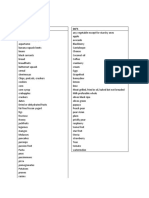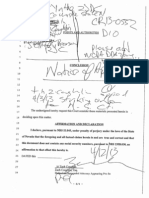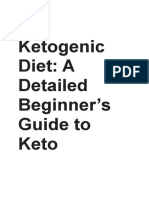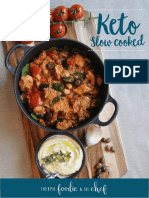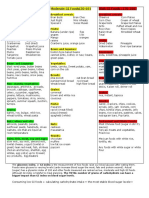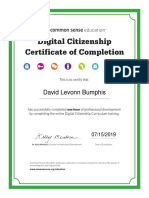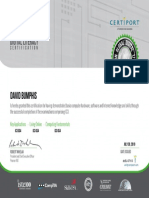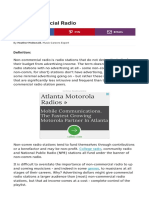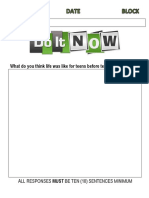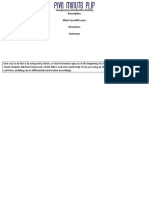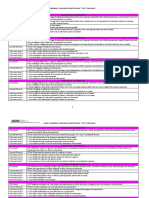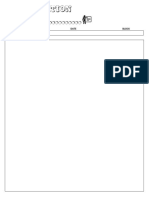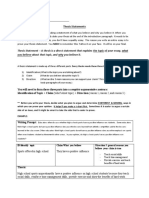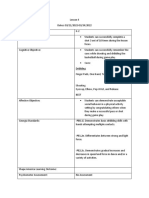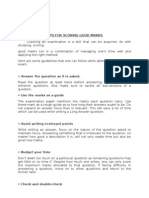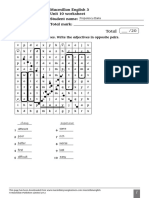Professional Documents
Culture Documents
Low Sodium Diet
Low Sodium Diet
Uploaded by
David BumphisOriginal Description:
Copyright
Available Formats
Share this document
Did you find this document useful?
Is this content inappropriate?
Report this DocumentCopyright:
Available Formats
Low Sodium Diet
Low Sodium Diet
Uploaded by
David BumphisCopyright:
Available Formats
Low Sodium Diet
How much sodium can I have?
A 1,500 to 2,000 to milligrams (mg) sodium diet is as part of a healthy eating
plan and helps to maintain a lower blood pressure and prevent swelling from
extra water build up in the body. Your doctor may give you a different sodium
goal based on your health history.
What are some hidden sources of sodium?
Sodium is found in:
Table salt: 1 teaspoon contains 2,300 mg of sodium
Seasonings: onion salt, garlic salt, seasoning salt, seasoning blends
Leavening agents: baking powder (488 mg per teaspoon) and baking soda
(1,259 mg per teaspoon).
Additives and preservatives: brine, di-sodium phosphate, monosodium
glutamate, sodium erythorbate, sodium benzoate, sodium hydrozide,
sodium propionate, sodium sulfite, and sodium nitrite
What are some shopping tips for lowering sodium?
1. Choose fresh or largely unprocessed foods without added salt or sodium-
containing preservatives.
2. Read food labels carefully. Look at the serving size and the sodium
content per serving. Check out the Reference Table on page 4 to learn
more about food labeling definitions.
3. Choose "No Added Salt" or "Low Sodium" canned and frozen foods.
4. Stay away from boxed pasta and rice mixes with seasoning packets since
many of them contain over 600 mg sodium per serving.
UMHS Patient Food and Nutrition Services
-1-
5. Buy fresh meat instead of processed meat. Avoid "basted" or "self-basted"
products which may contain injected broth with salt. Meats marked as
"natural" may also contain injected broth with salt.
6. When buying lunch meat, look for “No Salt Added” or “Low Sodium”
products.
7. Look for low sodium cheeses, such as Swiss, goat or farmers cheese.
8. All fruit is generally low in sodium. Be aware that dried or canned fruits
may be higher in sodium from added sodium benzoate, a preservative.
How else can I cut down on sodium?
Teach your taste buds to want less sodium by searching for new recipes
without added salt. Before you know it, you will like these foods better!
Try using a pinch of Citric Acid, also known as Sour Salt, as a salt
substitute. Citric acid adds a lemony tart taste. Use only a little bit
because it will make food taste sour. You can buy Citric Acid in the
canning aisle of stores.
Use a variety of salt-free herbs and spice blends for flavor during meal
preparation and at the table.
Infuse oils and vinegars with herbs to use as a finishing drizzle over
prepared foods or use them as a marinade. Try warming olive oil and
fresh rosemary in a saucepan over medium heat for one minute. Remove
from the heat and pour over sliced tomatoes. Let stand for 20 minutes.
Top beans, rice or pasta with the marinated tomatoes.
Compare food labels at the grocery store, choosing the lowest in sodium.
Check your local library, bookstore or search the internet for books on
low-sodium cooking. One example is the American Heart Association Low-
Salt Cookbook.
Many low fat and fat-free foods are higher in sodium, so choose wisely
when grocery shopping.
UMHS Patient Food and Nutrition Services
Low Sodium Diet
-2-
Look for “unsalted”, “No Added Salt” or “Low Sodium” versions of your
favorite foods.
Use salt-free seasonings to add flavor to foods without the sodium.
When dining out, ask that your foods are prepared without salt. It is best
to check online for restaurant nutrition information before leaving home.
Check out phone app's for tracking sodium content of individual and
restaurant foods.
Look for frozen dinners with 600 mg sodium or less. This may sound like
a lot of sodium, but it may be a better choice than some restaurant meals.
Medications may contain sodium, such as antacids, laxatives and
antibiotics. Ask your pharmacist if you have questions.
What are some ingredients I could use in place of salt?
1. Use the juice of lemons or limes.
2. Add different types of vinegar.
3. Replace garlic and onion salts with garlic and onion powder or use the
fresh versions for an even zestier taste.
4. Do not use a salt-substitute containing potassium-chloride unless you
check with your doctor or dietitian.
5. Spend time in the spice aisle at the grocery store and you’ll be amazed at
all of the salt-free seasoning options available. You can also make your
own spice blends!
UMHS Patient Food and Nutrition Services
Low Sodium Diet
-3-
Understanding Food Labeling Terms
This reference table will help you learn the definitions of terms often used on
food labels.
One serving contains no more
Choose These: Sodium free than 5 mg sodium.
One serving contains no more
Very low sodium than 35 mg sodium.
One serving contains no more
Low sodium than 140 mg of sodium.
Check the The sodium content has been
Sodium Content Light or Lite reduced by 50% compared to its
of These sodium regular version.
The sodium content has been
Reduced or Less reduced by 25% as compared to
sodium the reference food.
One serving contains 480 mg
Avoid These High Sodium sodium or more; or 20% Daily
Value or more.
UMHS Patient Food and Nutrition Services
Low Sodium Diet
-4-
Food Groups (Daily Recommended Recommended Sodium per
Servings) Serving Size serving
Starchy Grain Products (6-11 Servings
per day)
Unsalted cooked cereal, rice, pasta ½ cup 0-5 mg
Ready to eat cereal, low sodium ½ cup 0-140 mg
Bread 1 slice 110-175 mg
Corn tortillas 2 4-inch pieces 5-10mg
Fruit (2-2 ½ cups/day)
Fresh, frozen or canned ½ cup 0-5 mg
Vegetables (2-2 ½ cups servings per day)
Fresh or frozen, without added salt ½ cup 1-70 mg
Low Sodium or No Salt Added canned ½ cup 0-140 mg
Low Fat or Skimmed Milk Dairy Products
(2 servings per day)
Milk 1 cup 120 mg
Yogurt 8 ounces 160 mg
Low Sodium Cheese: Swiss, Goat or 1 ounce 54-110 mg
Farmers Cheese
Meat, Fish and Poultry (5-7 ounces per
day)
Fresh Meat, Fish or Poultry 3 ounces 30-90 mg
Tuna, No Salt Added 3 ounces 34-45 mg
Nuts and Beans (1 serving per day)
nuts, unsalted 1/3 cup 0-5 mg
Beans, cooked from dried or frozen ½ cup 0-5 mg
without salt
UMHS Patient Food and Nutrition Services
Low Sodium Diet
-5-
Sample Menu
Sodium
Content
Breakfast
1% Milk (8 ounces) 127 mg
Shredded Wheat (1 cup) 1 mg
Banana ( ½ medium) 1 mg
Toasted bread (1 slice) 147 mg
with soft margarine (1 teaspoon) & jam 30 mg
Lunch:
Pita Pocket Sandwich:
Pita bread (1/2 slice) 75 mg
Cooked chicken (3/4 cup) 75 mg
Lettuce and tomato slice 5 mg
Swiss cheese (1 ounce) 4 mg
1 medium apple 2 mg
Supper:
Salmon (3 ounces) 39 mg
Rice with mushrooms (1 cup) 2 mg
Steamed broccoli (3/4 cup) 48 mg
Coleslaw (shredded cabbage) with low sodium vinaigrette 160 mg
1 orange 1 mg
Evening Snack:
1 Peach 1 mg
Almond butter, unsalted (2 tablespoons) 2 mg
Vanilla yogurt (1/2 cup) 53 mg
Total Sodium of the Sample Menu 772 mg
*Sodium Values were taken from the USDA National Nutrient Data Base
UMHS Patient Food and Nutrition Services
Low Sodium Diet
-6-
High Sodium Low Sodium
Disclaimer: This document contains information and/or instructional materials
developed by the University of Michigan Health System (UMHS) for the typical patient
with your condition. It may include links to online content that was not created by UMHS
and for which UMHS does not assume responsibility. It does not replace medical advice
from your health care provider because your experience may differ from that of the
typical patient. Talk to your health care provider if you have any questions about this
document, your condition or your treatment plan.
Patient Education by University of Michigan Health System is licensed under a Creative Commons
Attribution-NonCommercial-ShareAlike 3.0 Unported License. Last Revised 06/20/2016
UMHS Patient Food and Nutrition Services
Low Sodium Diet
-7-
You might also like
- CYBER FOUNDATIONS II SyllabusDocument4 pagesCYBER FOUNDATIONS II SyllabusDavid BumphisNoch keine Bewertungen
- A Lifetime of Low Carb Recipes by George Stella-P2PDocument329 pagesA Lifetime of Low Carb Recipes by George Stella-P2PSenka MuharemiNoch keine Bewertungen
- HCG DIET PHASE 3 Do's & Don'tsDocument7 pagesHCG DIET PHASE 3 Do's & Don'tsKelly BaldwinNoch keine Bewertungen
- Diabetes and You: Your Guide To Better Living With DiabetesDocument51 pagesDiabetes and You: Your Guide To Better Living With DiabetesdrjperumalNoch keine Bewertungen
- Bread, Other Cereals & PotatoesDocument1 pageBread, Other Cereals & PotatoesAmit Chaudhuri100% (2)
- 4 12 13 0204 065630 0552 Notice of Appeal NJCRC 73A Stamped Page With BatesDocument124 pages4 12 13 0204 065630 0552 Notice of Appeal NJCRC 73A Stamped Page With BatesZachCoughlinNoch keine Bewertungen
- Lasocki, The Life of Daniel DemoivreDocument3 pagesLasocki, The Life of Daniel DemoivrecafetindebuenosairesNoch keine Bewertungen
- KetoDocument5 pagesKetoCharmaine Kwin Rivera GramponNoch keine Bewertungen
- HCG Diet Recipe1Document8 pagesHCG Diet Recipe1Nadine LNoch keine Bewertungen
- A Randomized Trial of A Low-Carbohydrate Diet For Obesity - NEJMDocument16 pagesA Randomized Trial of A Low-Carbohydrate Diet For Obesity - NEJMMateo PeychauxNoch keine Bewertungen
- Upgrade Your Diet ChartDocument1 pageUpgrade Your Diet ChartgojanmajkovicNoch keine Bewertungen
- Low Carb Diabetic RecipesDocument43 pagesLow Carb Diabetic RecipesDayane Sant'AnnaNoch keine Bewertungen
- Exchange Plan Diet PDFDocument21 pagesExchange Plan Diet PDFMaria A.Noch keine Bewertungen
- Fitness: Nutrition PlanDocument18 pagesFitness: Nutrition PlanSawyer BrownNoch keine Bewertungen
- Lowering Your Blood Pressure With DASHDocument64 pagesLowering Your Blood Pressure With DASHAlexa TalianuNoch keine Bewertungen
- Guide For Eating After Gastric Bypass SurgeryDocument42 pagesGuide For Eating After Gastric Bypass Surgerymolly brown100% (3)
- Low Carb Diet Studies.Document5 pagesLow Carb Diet Studies.Kai HiwatariNoch keine Bewertungen
- 20 Delicious High-Protein FoodsDocument6 pages20 Delicious High-Protein Foodsraju634Noch keine Bewertungen
- Baking Substitute ChartDocument6 pagesBaking Substitute ChartSheena Karla MiñozaNoch keine Bewertungen
- Full Liquid DietDocument9 pagesFull Liquid Dietellie0017Noch keine Bewertungen
- Symptoms of Celiac and Gluten Sensitivity - Gluten Free Girl and The ChefDocument255 pagesSymptoms of Celiac and Gluten Sensitivity - Gluten Free Girl and The Chefmusatii0% (1)
- Gluten Allergy, Wheat & Corn Allergy: by Dr. Manik G. HiranandaniDocument4 pagesGluten Allergy, Wheat & Corn Allergy: by Dr. Manik G. Hiranandaniwolfpack2929100% (1)
- Mediterranean DietDocument8 pagesMediterranean DietAnna VilceaNoch keine Bewertungen
- A Visual Guide To Estimating Your Portion Sizes: Grains ExchangeDocument1 pageA Visual Guide To Estimating Your Portion Sizes: Grains ExchangedaniNoch keine Bewertungen
- Mediterranean Food ListDocument1 pageMediterranean Food ListSynettaNoch keine Bewertungen
- Diet & NutritionDocument117 pagesDiet & NutritionSubbalekshmiNoch keine Bewertungen
- No Sugar Guide 2023Document12 pagesNo Sugar Guide 2023Emille ReisNoch keine Bewertungen
- Some Popular Weight Loss ApproachesDocument5 pagesSome Popular Weight Loss ApproachesCass NaresNoch keine Bewertungen
- The Ketogenic Diet: A Detailed Beginner's GuideDocument20 pagesThe Ketogenic Diet: A Detailed Beginner's GuideSarthak Mishra100% (1)
- Foundation Free McDougall ProgramDocument61 pagesFoundation Free McDougall ProgramMatevž BrojanNoch keine Bewertungen
- Onion Dip Recipe: IngredientsDocument1 pageOnion Dip Recipe: IngredientsCris ronconiNoch keine Bewertungen
- Personalized Meal Plans Instruction GuideDocument3 pagesPersonalized Meal Plans Instruction GuidelexNoch keine Bewertungen
- 9 Surprising Health Benefits of Drinking TeaDocument4 pages9 Surprising Health Benefits of Drinking TeaTeddy AmryNoch keine Bewertungen
- The New Atkins Diet Low Carb Revolution Super Delicious Cookbook Collection Box Set #2 - NodrmDocument90 pagesThe New Atkins Diet Low Carb Revolution Super Delicious Cookbook Collection Box Set #2 - NodrmAndreeaNoch keine Bewertungen
- Keto SlowCooker PDFDocument17 pagesKeto SlowCooker PDFMia V.Noch keine Bewertungen
- Low Gylcemic Meal Planning PDFDocument2 pagesLow Gylcemic Meal Planning PDFKarlaNoch keine Bewertungen
- Biggest Loser Food GuideDocument8 pagesBiggest Loser Food GuideClaudia Urrutia100% (1)
- The Weight Watchers DietDocument15 pagesThe Weight Watchers DietCharms1310Noch keine Bewertungen
- Average Sodium Content of FoodsDocument2 pagesAverage Sodium Content of FoodsPrince AliNoch keine Bewertungen
- Rapid FAT Loss: Your Step-By-Step Keto Plan For WomenDocument32 pagesRapid FAT Loss: Your Step-By-Step Keto Plan For WomenVince SardinaNoch keine Bewertungen
- Gout Friendly Foods ListDocument3 pagesGout Friendly Foods ListCharles0% (1)
- Plants Plant Based Pantry RecipesDocument12 pagesPlants Plant Based Pantry RecipesAngelica GarciaNoch keine Bewertungen
- Kidney Food RecipesDocument11 pagesKidney Food RecipesLouie Cedrick Camposano TriaNoch keine Bewertungen
- Detailed Ketogenic Diet For EvryoneDocument16 pagesDetailed Ketogenic Diet For EvryoneAmit Raj100% (1)
- Top Foods To Avoid On The Keto Diet: ProketotipsDocument4 pagesTop Foods To Avoid On The Keto Diet: ProketotipsIoana Borcea100% (1)
- Baking With Coconut FlourDocument63 pagesBaking With Coconut FlourCrystal Lynn Keener Sciarini100% (1)
- Plate Method tcm28-442159Document2 pagesPlate Method tcm28-442159TRABAJOS DR. MÜSEL TABARES100% (1)
- How To Control Hypertension (High Blood Pressure) - Nutrition StudiesDocument3 pagesHow To Control Hypertension (High Blood Pressure) - Nutrition StudiesMatevž BrojanNoch keine Bewertungen
- 14day GlutenFree Meal PlanDocument10 pages14day GlutenFree Meal PlanAidenJacksNoch keine Bewertungen
- Dr. Blyden: ObesityDocument65 pagesDr. Blyden: ObesityBlyden NoahNoch keine Bewertungen
- SimpleKetoSystem Grocery Shopping List 2020-06-27Document5 pagesSimpleKetoSystem Grocery Shopping List 2020-06-27AllisonNoch keine Bewertungen
- Oxalate Food List (St. Joseph's)Document4 pagesOxalate Food List (St. Joseph's)Filipe RicardoNoch keine Bewertungen
- Patient Education Sheet: Anti-Inflammatory DietDocument1 pagePatient Education Sheet: Anti-Inflammatory DietramboriNoch keine Bewertungen
- Keto Diet What To DrinkDocument6 pagesKeto Diet What To DrinkCarola SalasNoch keine Bewertungen
- VP Daily Vitality DietDocument69 pagesVP Daily Vitality DietIbrahim VolpiNoch keine Bewertungen
- Overview of Weight WatchersDocument40 pagesOverview of Weight WatchersM woodhallNoch keine Bewertungen
- Paleo Diet Food List PDFDocument16 pagesPaleo Diet Food List PDFShahul HameedNoch keine Bewertungen
- Diabetes Healing RecipesDocument30 pagesDiabetes Healing RecipesthubtendrolmaNoch keine Bewertungen
- Keto DietDocument17 pagesKeto DietMatheus ColomboNoch keine Bewertungen
- Carbohydrates PDFDocument2 pagesCarbohydrates PDFa bNoch keine Bewertungen
- Diet For Diabetes Step by Step Guide - 636b5747Document69 pagesDiet For Diabetes Step by Step Guide - 636b5747vrunda shahNoch keine Bewertungen
- DC BasicsDocument28 pagesDC BasicsDavid BumphisNoch keine Bewertungen
- 2019 STEM Applications - FinalDocument81 pages2019 STEM Applications - FinalDavid BumphisNoch keine Bewertungen
- Podcast Rubric PDFDocument2 pagesPodcast Rubric PDFDavid BumphisNoch keine Bewertungen
- In Essay Form, Discuss How Going Through Disappointments Can Have A Positive SideDocument10 pagesIn Essay Form, Discuss How Going Through Disappointments Can Have A Positive SideDavid BumphisNoch keine Bewertungen
- Digital Citizenship COCDocument1 pageDigital Citizenship COCDavid BumphisNoch keine Bewertungen
- 7 & 8 Grade Choir Syllabus 2013: Mrs. McclainDocument3 pages7 & 8 Grade Choir Syllabus 2013: Mrs. McclainDavid BumphisNoch keine Bewertungen
- Bumphis IC3 CertifiedDocument1 pageBumphis IC3 CertifiedDavid BumphisNoch keine Bewertungen
- 1A Grade Getter PDFDocument1 page1A Grade Getter PDFDavid BumphisNoch keine Bewertungen
- Non Commercial Radio - HTMDocument6 pagesNon Commercial Radio - HTMDavid BumphisNoch keine Bewertungen
- What Do You Think Life Was Like For Teens Before Technology?Document1 pageWhat Do You Think Life Was Like For Teens Before Technology?David BumphisNoch keine Bewertungen
- Competency Introduction Activity Description: What You Will Learn: Directions: SummaryDocument2 pagesCompetency Introduction Activity Description: What You Will Learn: Directions: SummaryDavid BumphisNoch keine Bewertungen
- E Post CardDocument1 pageE Post CardDavid BumphisNoch keine Bewertungen
- CF2 PreReq PodCast TemplateDocument1 pageCF2 PreReq PodCast TemplateDavid BumphisNoch keine Bewertungen
- Issues, Building On Others' Ideas and Expressing Their Own ClearlyDocument2 pagesIssues, Building On Others' Ideas and Expressing Their Own ClearlyDavid BumphisNoch keine Bewertungen
- Presentation PointsDocument1 pagePresentation PointsDavid BumphisNoch keine Bewertungen
- Thesis Statements PracticeDocument2 pagesThesis Statements PracticeDavid BumphisNoch keine Bewertungen
- DR Muhammad Asad Chughtai: Curriculum VitaeDocument9 pagesDR Muhammad Asad Chughtai: Curriculum Vitaemuhammad chughtaiNoch keine Bewertungen
- LevamisoleDocument1 pageLevamisoleggkrishna2002Noch keine Bewertungen
- How To Configure and Test QoSDocument5 pagesHow To Configure and Test QoSHenryNoch keine Bewertungen
- Special 16Document6 pagesSpecial 16Thu AnNoch keine Bewertungen
- Ntroduction: Yichun University Is Located in Yichun City, Jiangxi Province P.R.ChinaDocument3 pagesNtroduction: Yichun University Is Located in Yichun City, Jiangxi Province P.R.ChinaAmjad BhuttaNoch keine Bewertungen
- TG - Apo On The WallDocument7 pagesTG - Apo On The WallAllira Clarion BarazonaNoch keine Bewertungen
- Photographs of Hoarding Sites: MHADA MumbaiDocument63 pagesPhotographs of Hoarding Sites: MHADA MumbaiJoint Chief Officer, MB MHADA100% (1)
- Glossary 2º EsoDocument2 pagesGlossary 2º Esoanelia0210Noch keine Bewertungen
- Volleyball TheoryDocument9 pagesVolleyball TheoryIrene Martúnez GarcíaNoch keine Bewertungen
- PVS800 Central Inverters Flyer 3AUA0000057380 RevN en LowresDocument6 pagesPVS800 Central Inverters Flyer 3AUA0000057380 RevN en LowressabitavabiNoch keine Bewertungen
- Lesson 4 Basketball Lesson Plan k-2Document2 pagesLesson 4 Basketball Lesson Plan k-2api-604120454Noch keine Bewertungen
- Business Studies Class Xii Revised Support MaterialDocument202 pagesBusiness Studies Class Xii Revised Support Materialprachiroses0% (3)
- CS-250 Data StructuresDocument67 pagesCS-250 Data StructuresMuhammad TalhaNoch keine Bewertungen
- Cesc - Q4 - Las 3 - RTPDocument4 pagesCesc - Q4 - Las 3 - RTPSuper ManNoch keine Bewertungen
- 1 Lindapter Maggio 2023Document84 pages1 Lindapter Maggio 2023CALGERINoch keine Bewertungen
- Our World 4 - Grammar WorkbookDocument50 pagesOur World 4 - Grammar WorkbookJuanCarlosMadridNoch keine Bewertungen
- IELTS Speaking Mock Test 1Document8 pagesIELTS Speaking Mock Test 1Nguyễn Ngọc Minh AnhNoch keine Bewertungen
- Oracle: Oracle Cloud Infrastructure Foundation 2020Document22 pagesOracle: Oracle Cloud Infrastructure Foundation 2020Manish NayakNoch keine Bewertungen
- Gmail - Jain - Pranay Mradt KrabiDocument4 pagesGmail - Jain - Pranay Mradt KrabiPranay JainNoch keine Bewertungen
- Total: Macmillan English 3 Unit 10 Worksheet Student Name: Total MarkDocument3 pagesTotal: Macmillan English 3 Unit 10 Worksheet Student Name: Total MarkMiriam ScaralNoch keine Bewertungen
- Infinger V Harris CountyDocument16 pagesInfinger V Harris CountyThe TexanNoch keine Bewertungen
- Cambridge English - A2 Flyers - Flash Cards - CherryDocument32 pagesCambridge English - A2 Flyers - Flash Cards - CherryLê Ngọc Thùy VyNoch keine Bewertungen
- Fundamentals of Argumentation Theory Curs 4 (Unexpressed Standpoints and Unexpressed Premises)Document24 pagesFundamentals of Argumentation Theory Curs 4 (Unexpressed Standpoints and Unexpressed Premises)Laura Georgiana ŞiuNoch keine Bewertungen
- A Study On Employee Engagement in IT SectorDocument9 pagesA Study On Employee Engagement in IT SectorMaha SudharsanNoch keine Bewertungen
- Comfort Shoes: Udhaya Chandran S. B Rakesh G. RDocument19 pagesComfort Shoes: Udhaya Chandran S. B Rakesh G. RRakesh GrrNoch keine Bewertungen
- Assignment File pdf-3Document3 pagesAssignment File pdf-3Sumita SrivastavaNoch keine Bewertungen
- EKISTICSDocument3 pagesEKISTICSJosh JoshuaNoch keine Bewertungen
- Structures Deliverables For DTACDocument2 pagesStructures Deliverables For DTACAndreea BaciuNoch keine Bewertungen


